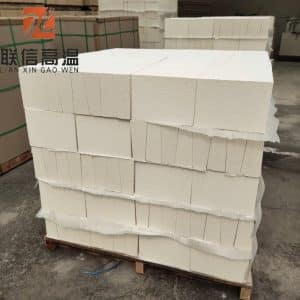High-aluminum poly light insulation brick, an advanced refractory material, is highly regarded in the industrial field for its excellent performance and wide range of uses. The following will discuss in detail the characteristics and applications of high-aluminum poly light insulation bricks to help you understand this material more comprehensively.https://youtube.com/shorts/8G2XRJQNOvE?feature=share
Characteristics of high-aluminum poly light insulation bricks
Lightweight and high strength: High-aluminum poly light insulation bricks have a low density, usually between 0.6-1.0g/cm³, but the strength can reach 5-20MPa. This light and high-strength feature allows it to reduce structural loads while ensuring sufficient mechanical strength.
High refractoriness: The refractoriness is as high as 1300℃, which can meet the use requirements of high-temperature equipment. This means that high-aluminum poly light insulation bricks can maintain stable physical and chemical properties in extreme environments.

High-aluminum poly light insulation brick
https://www.lxrefractory.com/product/alumina-bubble-brick
Thermal insulation: It has excellent thermal insulation properties, and its thermal conductivity is only 0.2-0.4W/(m·K). This helps to reduce energy consumption and improve thermal energy utilization efficiency.
Corrosion resistance: It can resist the erosion of various chemical substances such as acid, alkali, and salt, and is particularly suitable for use in harsh environments such as the chemical industry.
Convenient construction: Due to standardized size, high-aluminum polylight insulation bricks are easy to install and construct. At the same time, its light weight makes it easy to carry and install, greatly reducing the difficulty of construction.
Uses of high-aluminum polylight insulation bricks
Industrial kiln lining: In the kiln lining of metallurgy, ceramics, chemical industry and other industries, high-aluminum polylight insulation bricks can effectively isolate the heat transfer inside and outside the furnace body, improve energy utilization efficiency, and reduce fuel consumption.
Insulation layer: The insulation layer used for kilns and other high-temperature equipment can reduce the weight of the furnace body, shorten the kiln time, reduce heat diffusion, and protect the furnace temperature uniformity.
Direct contact with flame parts: Although the direct contact temperature of high-aluminum polylight insulation bricks shall not exceed 1350℃, it can still play an excellent insulation effect in parts that are not directly in contact with flames, such as the insulation layer of the kiln and parts without strong erosion and scouring of high-temperature molten materials.
Special occasions: In special occasions that require high temperature resistance and heat insulation, such as pyrolysis furnaces, hot blast furnaces, ceramic roller kilns, etc., high-aluminum poly-light insulation bricks also show their irreplaceable application value.
Wide range of industrial fields: In high-temperature equipment in the steel, metallurgy, chemical industry, building materials and other industries, high-aluminum poly-light insulation bricks are widely used due to their unique properties to protect the furnace structure, improve energy efficiency and extend the service life of the equipment.
In summary, high-aluminum poly-light insulation bricks play an important role in industrial kiln linings, insulation layers and other fields with their light weight, high strength, high refractoriness, thermal insulation, corrosion resistance and convenient construction. Its wide application prospects and significant energy-saving effects make it one of the indispensable materials in modern industrial production. With the continuous development of science and technology, the performance of high-aluminum poly-light insulation bricks will be further optimized, and the application field will be more extensive, providing more powerful support for energy conservation, emission reduction and safe operation of high-temperature industrial equipment.
